RAF Sculthorpe
Sculthorpe Airfield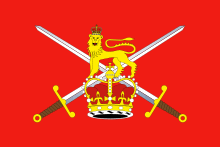 | |||||||||||||||||||
|---|---|---|---|---|---|---|---|---|---|---|---|---|---|---|---|---|---|---|---|
|
Aerial photograph mosaic of Sculthorpe airfield looking north, the main runway runs diagonally, the technical and bomb dump are on the left, 31 January 1946. | |||||||||||||||||||
| IATA: none – ICAO: EGUP | |||||||||||||||||||
| Summary | |||||||||||||||||||
| Airport type | Military | ||||||||||||||||||
| Owner | Ministry of Defence | ||||||||||||||||||
| Operator | Royal Air Force | ||||||||||||||||||
| Location | near Fakenham, Norfolk, England | ||||||||||||||||||
| Coordinates | 52°50′54″N 000°45′38″E / 52.84833°N 0.76056°ECoordinates: 52°50′54″N 000°45′38″E / 52.84833°N 0.76056°E | ||||||||||||||||||
| Map | |||||||||||||||||||
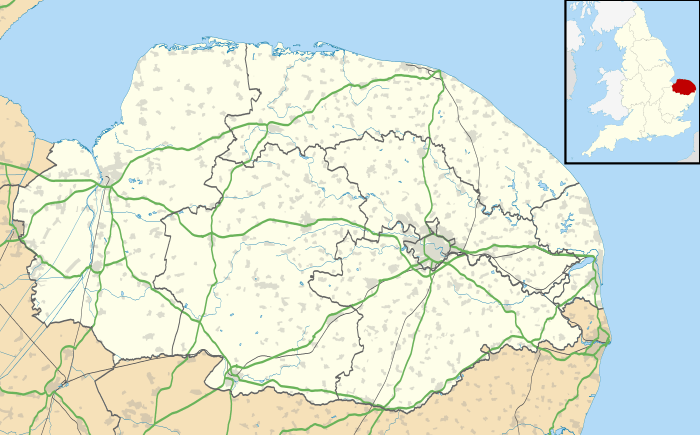 EGUP Location in Norfolk | |||||||||||||||||||
| Runways | |||||||||||||||||||
| |||||||||||||||||||
|
Now part of the Stanta training area | |||||||||||||||||||
Royal Air Force Station Sculthorpe  | |
|---|---|
| Part of Royal Air Force | |
| Coordinates | 52°50′54″N 000°45′38″E / 52.84833°N 0.76056°E |
| Type | Air Force Base |
| Site information | |
| Owner | Ministry Of Defence |
| Controlled by | Ministry Of Defence (Defence Estates/Landmarc) |
| Site history | |
| Built | 1942 |
| In use | 1943-present |
RAF Sculthorpe is a military training facility for the United Kingdom's Ministry of Defence, situated about 3 mi (4.8 km) west of Fakenham in Norfolk, England. The airfield has been home to many visiting airmen and support crews of the RAF and United States Air Force. Whilst retaining the airfield in 1997 the Ministry of Defence sold the entire technical, domestic and administrative site including the married quarters site previously occupied by the USAF to The Welbeck Estate Group.
History
World War Two
RAF Sculthorpe was built as the second satellite airfield of RAF West Raynham a few miles to the south, the first being RAF Great Massingham. Work was begun in the spring of 1942 and the airfield was laid out as a standard RAF heavy bomber airfield with concrete runways, dispersals site, mess facilities and accommodation. Much of the construction work was completed by Irish labour working for the construction company Bovis.
As work was drawing to a close in May 1943 the first squadrons started to arrive, the first being 342 (Lorraine) Squadron of the Free French Air Force within 2 Group from RAF West Raynham. This squadron operated two flights of the Douglas Boston aircraft along with some Douglas Havoc aircraft for training, 342 Squadron stayed until 19 July 1943 when they moved to RAF Great Massingham.
On 20 July 1943 the Royal New Zealand Air Force and Royal Australian Air Force moved in with No. 487 Squadron RNZAF and No. 464 Squadron RAAF taking up residence with their Lockheed Ventura aircraft having moved from RAF Methwold before converting at Sculthorpe onto the De Havilland Mosquito. On 20 September 1943 21 Squadron moved in from RAF Oulton, also with Mosquitos to form the Sculthorpe Wing (No. 140 Wing RAF). The wing stayed at Sculthorpe completing more than 100 missions before departing for RAF Hunsdon on 31 December 1943.
In January 1944 100 Group Royal Air Force No. 214 Squadron RAF moved in with Boeing Flying Fortress aircraft for use in electronic warfare support of Bomber Command to be joined by crews from the USAAF 96th Bomb Group from RAF Snetterton Heath, known at Sculthorpe and thereafter as the 803rd Bomb Squadron of the USAAF. In April 1944 the 803rd and 214 Squadron departed for RAF Oulton leaving Sculthorpe empty for its redevelopment as a Very Heavy Bomber Base with the work not being completed until the spring of 1946.
Cold War

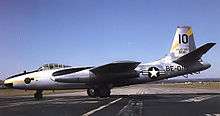
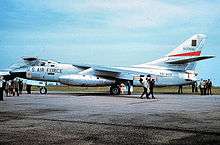

Sculthorpe was refurbished for USAF use during the Berlin Crisis in 1949 and then later, in 1952, it became home for the 49th Air Division (Operational) and the 47th Bombardment Wing, who were to stay for a decade. The 49th Air Division maintained operational control of the 47th Bomb WG and the 20th Fighter-Bomber Wing which provided tactical nuclear weapons support to the Supreme Allied Commander Europe (SACEUR). Later the 81st Fighter-Bomber Wing was provided a nuclear capability and assigned to the operational control of the 49th Air Division.
The Soviet Union's enormous conventional force in eastern Europe posed a major problem for NATO due to the Soviets maintaining high personnel levels after World War II when most of the American and British forces had demobilized.
To counter this Soviet threat to western Europe, NATO decided to expand their tactical nuclear force by introducing the North American B-45 Tornado to the UK. The US Tactical Air Command had about 100 of these four-engined jet bombers, each capable of dropping five tactical nuclear bombs. In the summer of 1952, the Pentagon decided to deploy the 47th Bomb Wing to Sculthorpe from Langley Air Force Base, Virginia. The movement of the 49th AD, 47 Bomb Wg and the 20th FB WG was the first unit deployment since World War II.
The squadrons of the 47th Bomb WG were:
- 84th Bombardment Squadron (B-45, B-66) (17 November 1952 – 22 June 1962)
- 85th Bombardment Squadron (B-45, B-66) (17 November 1952 – 22 June 1962)
- 420th Air Refueling Squadron (KB-29, KB-50) (25 September 1955 – 23 March 1962)
- 86th Bombardment Squadron (B-45, B-66) (23 March 1954 – 22 June 1962)
- 19th Tactical Reconnaissance Squadron (RB-45C) (7 May 1954 – 1 December 1958)
Due to a shortage of space at Sculthorpe, the 86th BS operated from RAF Alconbury as a detachment of the 47th. In addition to the B-45 squadrons at Sculthorpe, the 47th's sister wing, the 20th Fighter-Bomber Wing with the nuclear capable North American F-84G "Thunderjet" were transferred to RAF Wethersfield in Essex.
From 1954 to 1958, the 19th Tactical Reconnaissance Squadron also flew the reconnaissance version of the B-45 known as the RB-45. The 19th TRS was assigned to the 47th Bomb Wing from May 1954 to December 1958. When the 19th began to re-equip with RB-66's during 1957, its RB-45's were transferred to other squadrons of the 47th Bomb Wing.
By 1957, carrying 10,000 personnel it was the biggest USAFE base in Europe. In May 1958, the re-equipment of the 47th Bombardment Wing began and Douglas B-66 Destroyers began to replace the B-45s. With this equipment change, the 47th's squadrons was redesignated Bombardment Squadron (Tactical).
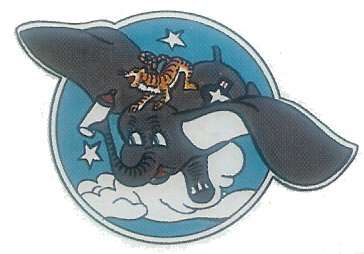
During 1960–1962 the 47th also performed air refueling missions assigning KB-50J tankers to the 420th Air Refueling Squadron from 15 March 1960 to 22 June 1962. The KB-50s were specially equipped with two General Electric J47 turbojet engines that enabled the tankers to match the speed of the faster jet fighters during refueling; however most of the KB-50s were more than fifteen years old and were too slow to refuel the faster tactical jets of USAFE. The 420th ARS was inactivated on 25 March 1964.
In 1962 Project Clearwater halted large scale rotational bomber deployments to Britain with Sculthorpe, along with RAF Fairford, RAF Chelveston, and RAF Greenham Common, being turned over to USAFE for tactical air use. As a result, the 47th Bomb Wing was inactivated on 22 June 1962. A number of the aircraft were reassigned to the 42nd TRS, 10th Tactical Reconnaissance Wing at RAF Chelveston and modified with the Electronic Counter-Measures tail system. With the inactivation of the 47th, Sculthorpe was put under the command of the 7375th Combat Support Group, the 7375th was later replaced by the Detachment 1, 48th Tactical Fighter Wing .
In spring 1982 units from RAF Coltishall moved to Sculthorpe while the runway was resurfaced
During the spring and summer of 1983, units of the 48th Tactical Fighter Wing deployed to RAF Sculthorpe because their home station, RAF Lakenheath was having its runway resurfaced.
During the summer of 1984 the F-4E and F-4G squadrons from Spangdahlem AB,West Germany operated from RAF Sculthorpe to allow runway re-surfacing at Spangdahlen to take place.
During most of 1988 and part of 1989, deploying C-130 units from the 463rd TAW (Dyess AFB, TX), the 314th TAW (Little Rock AFB, AR), and the 317th TAW (Pope AFB, NC) were forced to operate from RAF Sculthorpe due to runway resurfacing at RAF Mildenhall.
In August 1989 the TR-1A squadron from RAF Alconbury operated from RAF Sculthorpe whilst Alconbury's runway was re-surfaced.
Present day
The airfield became inactive at the end of the Cold War. During the mid 1990s the entire technical and domestic site was sold to the Welbeck Estate Group by Defence Estates. The domestic married quarters site included a sizeable number of single storey "tobacco houses". The housing estate was renamed "Wicken Village" and, after refurbishment, the houses were sold. The remaining technical site including barrack blocks, post exchange (PX), church, guardroom, gymnasium, community centres, and extensive storage and industrial units were sold to a single purchaser and there is now a fledgling industrial park. The Welbeck Estate Group went on to acquire the nearby technical and married quarter estate at RAF West Raynham.
The airstrip area remains in military hands, officially as an army helicopter training area, and is used for exercises about twice a year. Demolition work on the hangars began in March 2009.
The airfield is currently (2016) being used by the USAF 352nd SOG, based at RAF Mildenhall, to perform training in low flying, airdrops, and rescue & recovery missions. These exercises are conducted by C-130 Hercules and CV-22 Ospreys on occasional evenings, while fast jets from Lakenheath and Marham appear from time to time.
The only buildings that remain are the control tower, the fire station (next to the control tower) and a small half-moon concrete shelter, now used by a farmer for machinery and equipment storage. There are up to 2,000 cows on the grassed areas.
See also
- List of Royal Air Force stations
- United States Air Forces in Europe
- United States Air Force in the United Kingdom
- Strategic Air Command in the United Kingdom
References
- Ravenstein, Charles A., Air Force Combat Wings Lineage and Honors Histories 1947-1977, Office of Air Force History, 1984
- Endicott, Judy G., USAF Active Flying, Space, and Missile Squadrons as of 1 October 1995. Office of Air Force History
- Menard, David W., Before Centuries. USAFE Fighters 1948-1959
- Martin, Patrick, Tail Code: The Complete History Of USAF Tactical Aircraft Tail Code Markings, 1994
- USAAS-USAAC-USAAF-USAF Aircraft Serial Numbers--1908 to present
External links
| Wikimedia Commons has media related to RAF Sculthorpe. |
